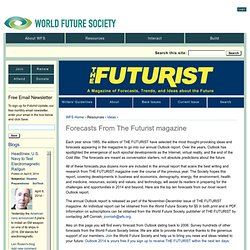

THE URBAN CONDITION IN 2027 ? Forecasts From The Futurist magazine. Each year since 1985, the editors of THE FUTURIST have selected the most thought-provoking ideas and forecasts appearing in the magazine to go into our annual Outlook report.

Over the years, Outlook has spotlighted the emergence of such epochal developments as the Internet, virtual reality, and the end of the Cold War. The forecasts are meant as conversation starters, not absolute predictions about the future. All of these forecasts plus dozens more are included in the annual report that scans the best writing and research from THE FUTURIST magazine over the course of the previous year. The Society hopes this report, covering developments in business and economics, demography, energy, the environment, health and medicine, resources, society and values, and technology, will assist its readers in preparing for the challenges and opportunities in 2014 and beyond.
Here are the top ten forecasts from our most recent Outlook report. 1. From “Mapping the Future with Big Data,” July–August 2013. Back-Casting From 2043. When it’s busy like this the viz sometimes shifts like the color bleed you used to see on those old Sunday comics, way back in the day.

Ubiquitous fiber pipes & wide-band wireless still can’t give enough bandwidth to the teeming multitudes downtown. The viz starts to lag, gets offset and even orphaned from the hard world it’s trying to be a part of. Hyperclear Ray Ban augments, lenses ground down by hand-sequenced rock algaes to such an impossibly smooth uniformity, run through with transparent circuity & bloodied rare-earth elements, scanning the world in multiple dimensions, pinging the cloud at 10GHz and pushing articulated data forms through massive OLED clusters just to show me where I can find an open null shield and the best possible cup of coffee this side of Ethiopia. Marks are flickering in & out, overlapping & losing their z-order. 20:20 Vision.
By Mary Brandel August 23, 2010 06:00 AM ET Computerworld - Information technology has always been a fast-changing field.

But nothing compares to the expected sea changes in the next decade that will impact the career plans of every generation of IT worker. "The rate of change has accelerated dramatically," says Alain Chesnais, president of the Association for Computing Machinery (ACM) and founder of Visual Transitions, which specializes in computer graphics and social networks. Consider, he says, that graphics chips are doubling in capacity every six months. As the effects of these types of advances ripple across the corporate world and combine with the forces of the Web, mobile computing, consumerization and virtualization, "traditional IT organizations won't look [the way] they do now," says Thomas Druby, an IT executive and former CIO at a large insurer.
The Pipeliners These are the college students who are getting degrees now and will fill payrolls in 2020. Futurist Speaker Thomas Frey – Celebrity Keynote, Futurologist, Blogging Innovation » Essential Skills for 21st Century Survival (Part 1) By Venessa Miemis Over the past few months, we’ve been discussing the various skills needed for effectively operating in a world characterized by information and accelerating change, and I’ve been assembling these ideas into a framework for a new thought architecture.

This post will be the first in a 12 part series, and draws its influences from the fields of Futures Studies, Complexity Science, Systems Theory, Cybernetics, Social Network Analysis, Knowledge Management, common sense, and exploration into my own thinking. All of the skills I’ll be covering are already in practice in our brains – it’s just a matter of becoming more aware of them so we can sharpen them.
I imagine them all happening concurrently and all reinforcing each other, creating constant feedback loops that raise consciousness and build intelligence. Though I’ll be identifying 12 areas, they’re mostly components of each other, so we’ll see how we might expand or refine these as the series rolls out. Pattern Recognition. FUTURESTATES.